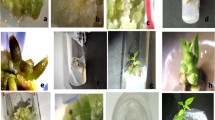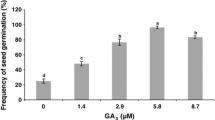Abstract
A method for the initiation of callus capable of plant regeneration from in vivo grown cormels of gladiolus (Gladiolus x grandiflorus Hort.) is described. Sliced cormels of the large-flowering hybrid, ‘Peter Pears’ were cultured in vitro on a modified Murashige and Skoog medium, supplemented with various auxins. Yellow callus, which was either friable or compact, could be induced on all media tested. Callus induced on media with naphthaleneacetic acid failed to proliferate. Callus induced on media with 9 mM 2,4-dichlorophenoxyacetic acid showed the best growth. Addition of micro-elements and vitamins increased the induction and growth of callus capable of plant regeneration. Explants taken from the middle part of the cormels had the highest competence for callus initiation. Callus was induced on several gladiolus hybrids and the South African species G. garnierii Klatt. Callus induction was genotype dependent and among the cultivars tested, ‘Peter Pears’ and ‘White Prosperity’ were superior with respect to callus production on the media with either 2,4-dichlorophenoxyacetic acid or picloram. Plants were regenerated from yellow compact callus of all genotypes on media containing zeatin and benzyladenine in various concentrations.
Similar content being viewed by others
Abbreviations
- 2,4-D:
-
2,4-dichlorophenoxyacetic acid
- MS:
-
Murashige and Skoog basal salt and vitamins (1962)
- CI:
-
callus induction medium
- NAA:
-
α-naphthaleneacetic acid
- BA:
-
6-benzyladenine
- picloram:
-
4-amino-3,5,6-trichloro-2-pyridinecarboxylic acid
- zeatin:
-
6-[4-hydroxy-3-methylbut-2-enylamino]purine
References
Adu-Ampomah Y, Novak F, Afza R & van Duren M (1988) Embryoid and plant production from cultured cocoa explants. Proceedings of the 10th Inter. cocoa research conference, Santo Domingo, Dominican Rep. 17–23 May 1987, (pp. 129–136). Cocoa Producers' Alliance, Lagos, Nigeria
Ammirato PV, Evans DA & Sharp WR & Bajaj YPS (1989) Handbook of Plant Cell Culture Vol. 5, Ornamental Species. McGraw-Hill, New York
Bajaj YPS (1992) Biotechnology in Agriculture and Forestry, Vol 20. High-Tech and Micropropagation IV (p. 497). Springer-Verlag, Berlin Heidelberg
Bajaj YPS, Sidhu MMS & Gill APS (1982) Some factors affecting the in vitro propagation of Gladiolus. Scientia Hort. 18: 269–275
Bajaj YPS, Sidhu MMS & Gill APS (1992) Micropropagation of Gladiolus. In: Bajaj YPS (Ed), Biotechnology in Agriculture and Forestry, Vol. 20, pp 135–143. High-Tech and Micropropagation IV Springer-Verlag, Berlin Heidelberg
Halperin W & Wetherell DF (1964) Adventive embryony in tissue culture of wild carrot, Daucus carota. Amer. J. Bot. 51: 271–283
Hussey G (1975) Totipotency in tissue explants and callus of some members of the liliaceae, iridaceae and amarillidaceae. J. Experimental Bot. 26: 253–262
Kamo K, Chen J & Lawson R (1990) The establishment of cell suspension cultures of Gladiolus that regenerate plants. In vitro Cell. Dev. Biol. 26: 425–430
Kamo K (1994) Effect of phytohormones on plant regeneration from callus of Gladiolus cultivar ‘Jenny Lee’. In vitro Cell. Dev. Biol. 30P: 265–31
Kim KW, Choi JB & Kwon KY (1988) Rapid multiplication of Giadiolus plants through callus culture. (Korean) J. Kor. Soc. Hort. Sci. 29: 312–318
Larkin PJ & Scowcroft WR (1981) Somaclonal variation — a novel source of variability from cell cultures for plant improvement. Theor. Appl. Genet. 60: 197–214
Mii M, Yuzawa Y, Suetomi H, Motegi T & Godo T (1994) Fertile plant regeneration from protoplasts of a seed-propagated cultivar of Lilium x formelongi by utilizing meristematic nodular cell clumps. Plant Sci. 100: 221–226
Murashige T & Skoog F (1962) A revised medium for rapid growth and bioassays with tobacco tissue cultures. Physiol. Plant. 15: 473–497
Olofsdotter M (1993) Image processing: a non destructive method for measuring growth in cell and tissue culture. Plant Cell Rep. 12: 216–219
Smith MAL, Meyer MJ & McClelland MT (1989) Non invasive image analysis evaluation of growth during plant micropropagation. Plant Cell Tiss. Org. Cult. 19: 91–102
Stefaniak B (1994) Somatic embryogenesis and plant regeneration of Gladiolus (Gladiolus hort.). Plant Cell Rep. 13: 386–389
Steinitz B, Cohen A, Goldberg Z & Kochba M (1991) Precocious Gladiolus corm formation in liquid shake cultures. Plant Cell Tiss. Org. Cult. 26: 63–70
van der Bulk RW (1991) Application of cell and tissue culture and in vitro selection for disease resistance breeding — a review. Euphytica 56: 269–285
Wilfret GJ (1971) Shoot-tip culture of Gladiolus: an evaluation of nutrient media for callus tissue development. Proc. Florida State Hortic. Soc. 84: 389–393
Ziv M, Halevy AH & Shilo R (1970) Organs and plantlets regeneration of Gladiolus through tissue culture. Ann. Bot. 34: 671–676
Author information
Authors and Affiliations
Rights and permissions
About this article
Cite this article
Remotti, P.C., Löffler, H.J.M. Callus induction and plant regeneration from gladiolus. Plant Cell Tiss Organ Cult 42, 171–178 (1995). https://doi.org/10.1007/BF00034235
Received:
Accepted:
Issue Date:
DOI: https://doi.org/10.1007/BF00034235




